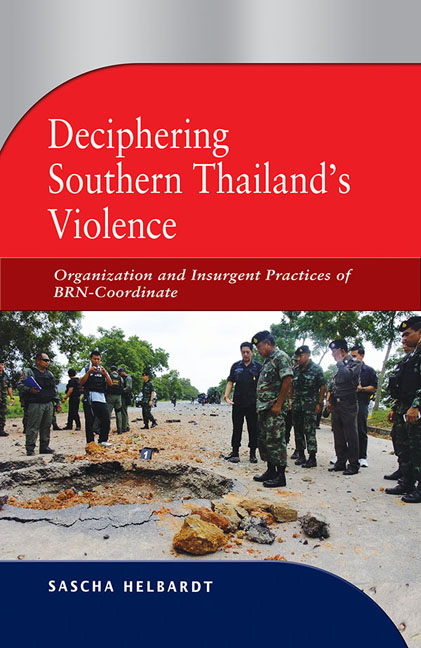Book contents
- Frontmatter
- Dedication
- Contents
- List of Figures
- List of Abbreviations
- Preface and Acknowledgments
- 1 Introduction
- 2 Organizational Aspects of BRN-Coordinate
- 3 Making Insurgents: Recruitment, Training and Control
- 4 Bringing the Actors Back In: Who Are the Insurgents?
- 5 Making Sense of Violence: Power and the Insurgency's Communicative Side
- 6 Conclusion
- References
- Bibliography
- About the Author
- Frontmatter
- Dedication
- Contents
- List of Figures
- List of Abbreviations
- Preface and Acknowledgments
- 1 Introduction
- 2 Organizational Aspects of BRN-Coordinate
- 3 Making Insurgents: Recruitment, Training and Control
- 4 Bringing the Actors Back In: Who Are the Insurgents?
- 5 Making Sense of Violence: Power and the Insurgency's Communicative Side
- 6 Conclusion
- References
- Bibliography
- About the Author
Summary
Until recently, the violent conflict in Southern Thailand had been captured in terms of historical oppression by the Thai state, and the economic and social exclusion of the Malays as well as related questions of legitimacy. In contrast to these narratives, this book argues that an analysis of the meanings of violence should not be reduced to the facades of popular narratives and declared intentions, as such an approach would place scholars themselves at risk of becoming part of the process of staging violence. Accordingly, this book explores the hidden channels of communication and the organized violence behind such facades in order to understand the enduring rebellion, which moves beyond dichotomous notions such as nationalism versus jihad, “new” network-like organized versus “old” vertically organized armed groups, or claim-taking versus silence.
To understand these ambivalences, it is important to take into account the ability of insurgent groups to adjust to changing social and political contexts. Similar to companies in a free market, they have to adapt and innovate constantly. To be successful, they must develop new violent and non-violent strategies that are able to both undermine state legitimacy and mobilize the masses. They have to be innovative in terms of their ideological repertoire in order to gain charismatic appeal; however, in doing so, they must stay within the lines of what is culturally accepted. The cost of failure can be much greater for them than for companies, as violence is a brutal mechanism of selection: in the best case, they simply fall by the wayside, while in the worst case, their members are killed in significant numbers and their political objective is left unrealized.
In reaction to the defeat of earlier Malay rebellions in Southern Thailand, BRN-Coordinate underwent a major organizational adjustment. Although other separatist groups gave up their old-style guerrilla fights in the 1980s and 1990s, BRN-Coordinate proved to be astonishingly capable of re-designing itself, thereby establishing the foundation for the latest round of insurgency. This transformation was twofold in nature. First, instead of full-time guerrillas hiding in the jungle, the current insurgency is based on a part-time guerrilla-cum-terrorist force that hides in the villages and takes advantage of the state's limited control at the local level. Second, the group introduced village-based mass indoctrination using a mixture of nationalism and the jihadist thought that had become globally prominent.
- Type
- Chapter
- Information
- Deciphering Southern Thailand's ViolenceOrganization and Insurgent Practices of BRN-Coordinate, pp. 232 - 238Publisher: ISEAS–Yusof Ishak InstitutePrint publication year: 2014



